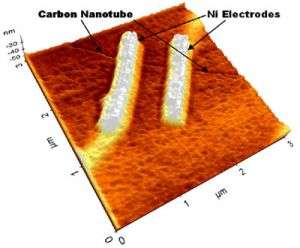Researchers Hope to Unlock Capabilities of Carbon Nanotubes

In a three-year project that researchers say could revolutionize the electronics industry, engineers at The University of Texas at Dallas are attempting to establish a standard means for tapping the potential of carbon nanotubes.
Ever since they emerged in the early 1990s, nanotubes have promised to enable a whole new wave of technology, including ultra-fast computers that leave today’s machines in their dust. But despite advances in manufacturing the tiny graphite cylinders, there’s still no standard approach for making electrical contact with them.
“We think carbon nanotubes are ideal candidates to be the building blocks of electronic devices of the future, but to exploit their unique properties you have to be able to connect them to the outside world,” said Dr. Moon Kim, a professor of electrical engineering in the Erik Jonsson School of Engineering and Computer Science at UT Dallas and the project’s principal investigator. “This will be the first time anyone has determined the extensive metal contacts that need to be established with nanotubes in order to incorporate them into new technology.”
Carbon nanotubes are particularly attractive because of their ability to carry electrical current without dissipating much heat, and heat loss is one of the semiconductor industry’s chief enemies as silicon chips’ physical features become ever smaller.
Nanotubes themselves bring new meaning to the word “small.” Their walls can be just one atom thick, forcing researchers to find a way to make an electrical connection between our big clunky world and nanotubes’ almost impossibly small one.
The $225,000 grant that’s funding the research is one of eight awarded through the new Nano-Bio-Information Technology Symbiosis program, or NBIT, jointly operated by the South Korean Ministry of Science and Technology and the U.S. Air Force Office of Scientific Research. The other U.S. universities receiving grants through the program are Harvard, Caltech, UC Berkeley, UCLA, UC San Diego, the University of Michigan and the University of Cincinnati.
“Not only is this research grant itself important, but it’s part of a trend in which we’ve been successfully competing and collaborating with some of the most prestigious engineering schools in the country,” said Dr. Bob Helms, dean of the Jonsson School. “And international collaborations like this are clearly going to be an increasingly important part of the way universities conduct research.”
The eight grant winners emerged from a field of more than 50 research proposals submitted to NBIT. Each grant involves collaborative research between U.S. and Korean researchers. The UT Dallas researchers are collaborating with a team from South Korea’s Sungkyunkwan University as well as a team from the University of Pittsburgh.
Source: University of Texas at Dallas





















